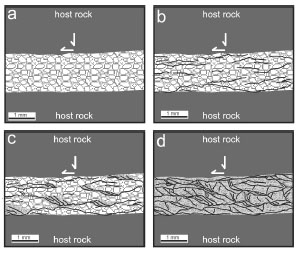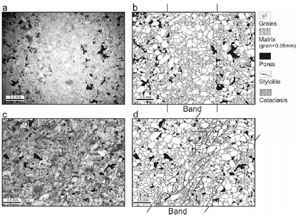| |||||||
|
|
|||||||
|
|
|||||||
| Faults in Carbonate Rocks, Majella Mountains, Italy | |||||||
|
Tondi et al. (2005, 2006) documented the deformation processes in porous Cretaceous carbonate grainstone at the Madonna della Mazza quarry in Majella Mountain, central Italy. They distinguished three main deformation mechanisms that operated in this area: (1) deformation bands by compaction and shear strain localization (Figure 1a), (2) stylolites by pressure solution (Figure 1b), and (3) subsequent shearing of the stylolites (Figures 1c, 1d). The host rock is a poor-to-medium consolidated carbonate grainstone. Grains are made up of fragments of rudist, ranging in size from 0.05 to 0.4 mm and accounting for about 53% of the rock volume (outside bands of Figures 2a and 2c). The matrix consists of bladed and sparry calcite cement, microspherules of silica cement, and rudist fragments smaller than 0.05 mm and makes up about 25% of the rock. The rock has an average porosity of about 22%. In the Madonna della Mazza quarry, six sets of deformation bands are identified. The oldest set of these occurs parallel to the bedding and is consistently offset by other bands. The bed-parallel set generally forms within the coarse-grained beds. They are not developed extensively and are made up of short, discontinuous segments with thicknesses ranging from 1 to 5 mm. The other five sets of deformation bands include bed-oblique compactive shear bands. All five sets of shear bands include either single bands or zones of several individual bands. Single bands are characterized by a thickness between 1 and 2 mm and offset between 1 and 2 mm. Zones of shear bands have thicknesses ranging from 2 mm to 5 cm and slip ranging from 2 mm to 5 cm. Comparing with that in host rock, the porosity in the band has been reduced from an average of 22% to less than 4% (Figure 2). This reduction in porosity, together with the interlocking of the grains, may shift the mechanical behavior of the rock from loose material to more solid-like, thereby enhancing the processes of pressure solution and later faulting. Despite the reduction in porosity, however, the grain to matrix ratio remain the same, indicating significantly that no grain fracturing or grain size reduction occurred (Figure 3).
The products of the pressure solution process are one set of bed-parallel solution seams and five bed-oblique sets. The bed-parallel set in many cases follows the interface between the fine- and coarse-grained depositional fabric. The oblique sets are each associated with and overprint the earlier sets of compactive shear bands. In the outcrop, pressure solution seams commonly show a negative relief, due to erosion along the weaker residues. Detailed geometry of the pressure solution seams varies from columnar to wavy types. The bed-parallel compaction bands and bed-parallel stylolites, which are kinematically compatible, are interpreted to be pre-tilting structures developed in response to the overburden, while the five sets of compactive shear bands and the associated stylolites and sheared stylolites likely occurred during the syn- and post-tilting deformation phases recorded in the Majella anticline. All six sets of stylolites help reduce the grain size and form cataclastic narrow zones within the band. Figure 3 summarizes the changes of porosity and grain to matrix ratio along the deformation path. As deformation further develops, the deformation bands and overprinting solution seams, with a cumulative offset of more than 20 cm, form tabular zones of breccia and fine grained cataclastic fault rocks with several slip surfaces (Figure 1d). This study features two highlights: 1) the occurence of bed-parallel deformation bands and their formation in carbonates, and 2) interactive failure mechanisms from strain localization to pressure solution and subsequent shearing and cataclasis in carbonate rock made possible by the reduction of porosity within deformation bands. | |||||||
| Reference: |
|||||||
| Tondi, E., Antonellini, M., Aydin, A., Marchegiani, L., Cello, G., 2005 Tondi, E., Antonellini, M., Aydin, A., Marchegiani, L., Cello, G., 2006 |
|||||||
|
Readme | About Us | Acknowledgement | How to Cite | Terms of Use | Ⓒ Rock Fracture Knowledgebase |
|||||||


